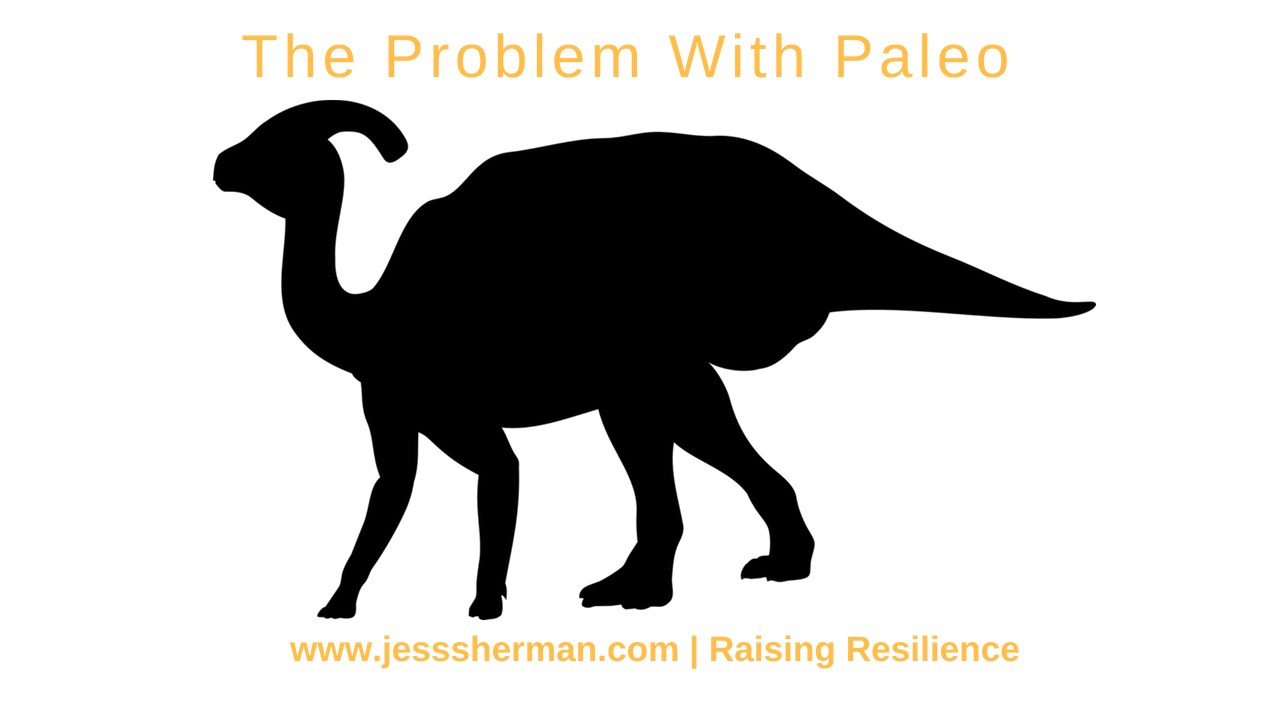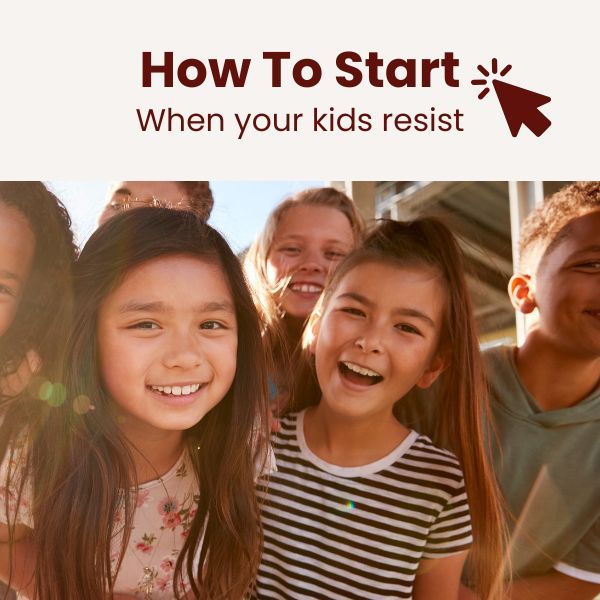The Problem With Paleo

Why Consider A Paleo Diet For Kids?
A Paleo-type diet is often recommended for myriad health issues including depression, ADHD, Autism chronic pain, and autoimmune disease.
The simplest definition of this diet strategy is to remove grains, dairy, and legumes and focus instead on meat, seafood, fruit, vegetables, nuts, and seeds.
I find Paleo to be helpful for children who struggle with self-regulation issues, particularly kids on the Autism spectrum. But Is a dairy and grain free diet safe for kids? This article will go through some of the common concerns and pitfall of implementing a Paleo diet with kids and how to avoid them so your Paleo child can experience the benefits of a Paleo approach while remaining well-noruished.
What's The Problem With Paleo?
A Paleo diet can stabilize mood, energy and blood sugar; it can also help relieve digestive distress and ease inflammation.
When we reduce inflammation, we see focus and sleep improve, learning and growth improve, and we often see emotions and mood stabilize.
But if we going to do Paleo with a child, we need to do it safely. So here are 3 common concerns parents have and how to deal with them.
Common Concern #1: Paleo Leaves Kids Nutritionally Deficient
The risk of nutritional deficiency is a valid concern any time you consider taking whole groups of food out of a child's diet.
Kids are in a stage of rapid growth and require massive amounts of nutrients and energy in a steady supply.
To avoid nutritional deficiency on a Paleo diet, there's an important mindset shift to consider.
Most people think of Paleo as an elimination approach. When you take that approach you open yourself up to nutritional deficiency. But a Paleo diet can be nutrient-rich. The key is to shift your perspective from this being an elimination of certain foods to being a substitution of certain foods for others.
When you think about it that way, you can do Paleo safely with your kids and see the benefits while avoiding the risk of nutritional deficiency.
Here are FIVE potential nutritional problems with Paleo and how to avoid them:
I am most concerned about the following nutrients when people take out grain, dairy, and legumes:
- Fibre,
- Folate,
- B12,
- B6,
- Calcium.
The Paleo no-no’s (like grains, legumes and dairy) are handy sources and these nutrients are critical for neurological health and development.
Because of their importance to the developing brain and body, I sometimes recommend that certain specific beans remain in the diet for children on a Paleo approach, even though traditionally they are left out (they're listed below). On occasion, I also recommend that some of the seed-like grains such as quinoa remain in too. But it all depends on the individual.
Here are foods to focus on to avoid these potential nutritional pitfalls of Paleo with kids (some of these foods are not traditionally allowed on the Paleo diet. I include them because they are handy sources. Whether your child can handle them might require some trial and error).
Find Calcium In:
- White and black sesame seeds,
- Almonds,
- Sunflower seeds,
- Walnuts,
- Sesame butter,
- Almond butter,
- Swiss chard, Kale,
- Green beans,
- Peas,
- Broccoli,
- Carrot,
- Avocado,
- Kidney beans,
- Wild rice
Find Fibre In:
- nuts,
- nut butters,
- all cooked and raw veggies,
- Jerusalem artichokes,
- jicama,
- plantain,
- fresh and dried fruit,
- flax seed,
- chia seed,
- psyllium seed,
- seaweeds,
- beans if tolerated
Find B-Vitamins (particularly 6 and 12) in:
- sunflower seeds,
- pine nuts,
- calf or chicken liver,
- beef heart,
- almonds,
- banana,
- grass-fed beef,
- spinach,
- sweet potato,
- hazelnuts,
- all meat, chicken, fish,
- chic peas,
- lentils,
- pistachios
Find Folate in:
Same as that listed for B vitamins as well as:
- leafy greens (spinach, chard, kale, beet greens),
- asparagus,
- broccoli,
- cabbage,
- black-eyed peas,
- kidney beans,
- lima beans,
- navy beans,
- walnuts
Important note about folate:
Folic acid is added to most grains and fortification (particularly of wheat and corn) is not always indicated on food labels.
An estimated 50-60% of us do not metabolize this folic acid well and are unable to use it due to our genetics (in the autistic population that percentage jumps to 98%!).
For these people, the synthetic folic acid they get from grains clogs up the folate receptor sites, reducing their ability to absorb natural folate and effectively causing folate deficiency.
Replacing fortified grains with the non-grain sources of natural folate mentioned here frees up the receptor sites while offering the body a more usable form of folate. Improved folate absorption might account for some of the benefits we see in kids when we remove synthetically fortified grains.
Common Concern #2: There Is Too Much Animal Protein In A Paleo Diet
We do have some good research to suggest that a diet high in animal protein and animal fat that is also low in plants and fiber can adversely affect gut microbes (then again, so can gluten).
If you’ve been following my work you’ll know that I’m all about supporting gut microbes!
This concern about the effect of animal protein and fat on microbes is, I think, valid. And it leads us to a very common pitfall with Paleo…. Don’t Forget The Veggies!
Paleo is just as much about what you put in as what you take out.
Paleo is not all about meat and fat. Vegetables contain protective nutrients that are a critical part of making this diet approach healthy for kids.
More and more human studies are being done looking at the effect of a Paleo-type diet on weight, metabolism, immune function, neurological processes and heart health that show us this way of eating can be very healthy. But it has to be done in a healthy way which means, in part, lots and lots of vegetables!
Common Concern #3: Paleo Is Too Restrictive; Gluten-Free Is Enough
Gluten is a type of protein found in grains. Wheat, rye, barley, spelt, and kamut are commonly thought of as “the gluten-grains”, while rice, millet, teff, quinoa, sorghum, and buckwheat are considered "gluten-free grains".
Many of the children I work with are gluten sensitive. It's not that surprising, since gluten is hard to digest and has been associated with over 200 medical symptoms and conditions including some cases of ADHD, anxiety, depression, autism, and autoimmune diseases.
Gluten has also been shown to potentially interfere with nutrient absorption and many of the kids I work with show symptoms of nutritional deficiency.
So is it enough to just take out the grains that are high in gluten? Do we really have to take out all grains?
The answer is, it depends.
Some kids can tolerate gluten-free grains like quinoa and rice, but some only see benefits when they take out all grains.
Here are two reasons why that might be.
1. Gluten-Free Grains Can Still Contain Gluten
There are over 200 different types of gluten. A type called gliadin is the one found in the "gluten grains" listed above; it is the type of gluten research has associated with Celiac disease. But all grains contain some type of gluten. A child might be fine with gliadin, but react to other types of gluten found in, say, corn and buckwheat.
2. Other potential issues with grains, other than gluten.
Food chemicals like phytic acid, lectins, and glutamate can also irritate the digestive and nervous system, as can the pesticide glyphosate which is sprayed on most non-organic grains before harvest. Perhaps in some cases it's the reduction of those when a child goes on a Paleo diet that accounts for the improvements in symptoms, not the gluten at all.
So, Where To Start With Paleo?
I have seen remarkable improvements in kids when they follow a Paleo diet. Children who struggle to self-regulate benefit when we reduce irritation. Doing so makes room for positive momentum by re-establishing nutritional status and allowing for digestive regeneration. The are many possible ways a Paleo diet can reduce irritation.
But Paleo can seem daunting, especially if you're not comfortable in the kitchen.
Diet changes have to be more helpful than they are stressful, so if you're considering trying a Paleo diet, be sure to plan ahead and get support if you need it.
In my coaching programs, I always start families off with a nourishing, whole foods diet. I strongly believe that it's important we start from a perspective of nourishment before we consider taking anything out of the diet, especially when dealing with kids. If your child is not yet eating a wide variety of whole foods, and you're not yet comfortable cooking them, that's the place to start.
Where we go next is going to depend on your child and family. I generally start families off with a healthy gluten-free diet and then gently move them towards a modified paleo diet, being careful to keep it nutritionally dense.
We stick with that for a trial period while carefully tracking symptoms and working on digestive regeneration. And at some point, we typically enter a re-introduction period.
Think About Concepts, Not Protocols
Let’s ditch the word “Paleo” and focus on your child, ok?
When trying to figure out what and how to feed your kids it’s more helpful to think about concepts than to adhere to a particular defined protocol.
Your child is an individual. With individual needs.
I find that a Paleo-type diet that removes dairy and grains (and any other allergens you’ve discovered) while heaping on the plants, quality meat, fish, and eggs (if tolerated) along with select beans and sometimes pseudo-grains (like millet and quinoa) can be a great diet for kids who are struggling with self-regulation, learning, focus or growth.
What's most important if you try Paleo with your kids, is that you still follow the Pillars Of Resilient Health. Your child's diet still needs to be full of good nutrition, you still have to explore all types of irritation (beyond dairy and grains), you still need to feed your child for blood sugar stability, you still need to do some digestive regeneration and support.
A Paleo approach can help, but it's not the end of the story.
Related Posts:
https://www.jesssherman.com/blog/child-mental-health
https://www.jesssherman.com/blog/how-to-ferment-foods-for-your-kids
https://www.jesssherman.com/blog/nutritional-approach-to-adhd-where-do-you-start
https://www.jesssherman.com/blog/does-diet-improve-autism
https://www.jesssherman.com/blog/aggression-in-kids-what-s-causing-it
—————————
References:
2011: Association of Attention-Deficit/Hyperactivity Disorder and Celiac Disease: A Brief Report
2012: Gluten- and casein-free dietary intervention for autism spectrum conditions
2012: Pennesi Christine M.; Klein Laura Cousino. Effectiveness of the gluten-free, casein-free diet for children diagnosed with autism spectrum disorder: Based on parental report. Nutritional Neuroscience.
2013: Diet, the human gut microbiota, and IBD
2014: Clinical and Mucosal Improvement With Specific Carbohydrate Diet in Pediatric Crohn Disease
2014: Nutritional Therapy in Pediatric Crohn Disease: The Specific Carbohydrate Diet
20014: Gluten- and casein-free diets for autistic spectrum disorder.
2015: Paleolithic nutrition for metabolic syndrome: systematic review and meta-analysis.






